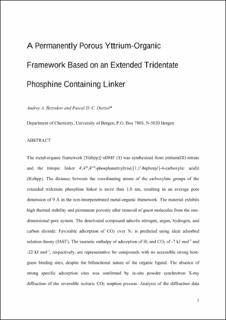| dc.contributor.author | Bezrukov, Andrey A. | |
| dc.contributor.author | Dietzel, Pascal D.C. | |
| dc.date.accessioned | 2024-03-05T09:17:46Z | |
| dc.date.available | 2024-03-05T09:17:46Z | |
| dc.date.created | 2017-11-29T17:18:02Z | |
| dc.date.issued | 2017 | |
| dc.identifier.issn | 0020-1669 | |
| dc.identifier.uri | https://hdl.handle.net/11250/3121031 | |
| dc.description.abstract | The metal–organic framework [Y(tbpp)]·nDMF (1) was synthesized from yttrium(III) nitrate and the tritopic linker tris(4′-carboxy[1,1′-biphenyl]-4-yl)phosphine (H3tbpp). The distance between the coordinating atoms of the carboxylate groups of the extended tridentate phosphine linker is more than 1.8 nm, resulting in an average pore dimension of 0.9 nm in the noninterpenetrated metal–organic framework. The material exhibits high thermal stability and permanent porosity after removal of guest molecules from the one-dimensional pore system. The desolvated compound adsorbs nitrogen, argon, hydrogen, and carbon dioxide. Favorable adsorption of CO2 over N2 is predicted using ideal adsorbed solution theory (IAST). The isosteric enthalpies of adsorption of H2 and CO2 of −7 and −22 kJ mol–1, respectively, are representative for metal−organic frameworks with no accessible strong host–guest binding sites, despite the bifunctional nature of the organic ligand. The absence of strong specific adsorption sites was confirmed by in situ powder synchrotron X-ray diffraction of the reversible isobaric CO2 sorption process. Analysis of the diffraction data indicates that the CO2 molecules in the pores are disordered and nonlocalized. Despite this, it was possible to quantify the evolution of the occupation of the pores. CO2 is adsorbed at an approximately constant below 320 K from 10% loading to full capacity at 195 K. | en_US |
| dc.language.iso | eng | en_US |
| dc.publisher | American Chemical Society | en_US |
| dc.title | A Permanently Porous Yttrium-Organic Framework Based on an Extended Tridentate Phosphine Containing Linker | en_US |
| dc.type | Journal article | en_US |
| dc.type | Peer reviewed | en_US |
| dc.description.version | acceptedVersion | en_US |
| dc.rights.holder | Copyright 2017 American Chemical Society | en_US |
| cristin.ispublished | true | |
| cristin.fulltext | postprint | |
| cristin.qualitycode | 2 | |
| dc.identifier.doi | 10.1021/acs.inorgchem.7b01574 | |
| dc.identifier.cristin | 1520460 | |
| dc.source.journal | Inorganic Chemistry | en_US |
| dc.source.pagenumber | 12830-12838 | en_US |
| dc.relation.project | Norges forskningsråd: 209339 | en_US |
| dc.relation.project | Norges forskningsråd: 247734 | en_US |
| dc.identifier.citation | Inorganic Chemistry. 2017, 56 (21), 12830-12838. | en_US |
| dc.source.volume | 56 | en_US |
| dc.source.issue | 21 | en_US |
